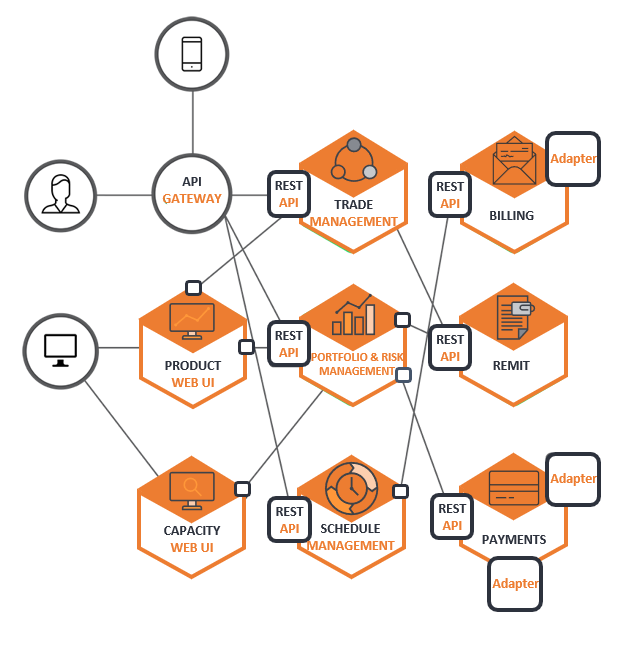
“Change is inevitable. Change is constant,” Benjamin Disraeli, British Prime Minister in the late 19th century once said in a speech. And while he meant change in politics, his words hold true for all walks of life, including business. Tim Cook could have said the same. Or Elon Musk, or Mary Barra. Stagnation is not a viable option.
The energy sector is certainly not standing still. Technological advances such as algorithmic trading, smaller granularity of data (e.g.: trading time periods, metering frequency etc.), remote maintenance, and smart meters are bringing about a profound transformation of how business is conducted. Since IT is indispensable to achieving a company’s operational and strategic goals, IT procurement has also assumed a crucial role. According to a recent forecast by Gartner, worldwide IT spending in 2021 is projected to increase by 6.2% from last year. In addition to these overall developments, the sector is also experiencing a shift: the number of procurement projects appears to be growing while their size is shrinking. Let us take a look at what is driving this change.
COVID-19: driven by need
For the past year, we have been living in the grip of a global pandemic, which has had a profound impact on the energy industry too. Although maintenance and some degree of plant and grid management still has to be done onsite, employees are now performing some of their tasks, such as monitoring operations, from home. In order to support these home office activities, many companies are migrating to the cloud.
Perhaps surprisingly to some, the industry is performing well. As recently as a year ago, home office and distance work (or distance service provision) were almost unthinkable since internal policies and security considerations did not allow companies to run certain tasks outside the local network. However, as the pandemic forced the entire industry to operate remotely, it became increasingly clear that disrupting the business-as-usual approach did have some advantages. The lockdown showed that critical infrastructure applications can be operated and serviced remotely in a secure and efficient way. It also made companies realize that cloud migration and other types of unconventional service provision were something to embrace.
The downside of introducing remote operations is that it exposes the industry to cyber-risks, therefore companies must ensure that remote work is secure and resilient. Monitoring for anomalies, for example, is gaining significance: the system needs to be able to distinguish between employees working from home and attackers. Some of that monitoring can be automated, but automation in general is becoming paramount.
Digitalization: driven by progress
Automation is a major goal of digitalization, for which there is an increased demand. While the word automation still has negative connotations of robots taking over people’s jobs, the distinct advantage is that automation can handle tedious, low-level work, freeing people to focus on more complex, higher-value tasks.
Predictive technologies, including those driven by AI, are also on the rise. The ability to predict the future more accurately and more granularly can impact several aspects of energy, e.g. hyper-local, short-term weather forecasts; wind and solar generation; smart auctioning and procurement; energy demand or price trends on the markets.
With the energy sector becoming increasingly keen to adopt the latest technology, new innovations keep being introduced, and - patterned after “Industry 4.0” - the term “Energy 4.0” is being used more and more frequently. It refers to smart and connected systems that can improve flexibility and efficiency: cloud computing, machine learning, real-time data exchange and demand side response are some of the areas that are undergoing something of a revolution.
Similarly, electrification and renewable energy infrastructures are getting greater recognition. Both are critical for decarbonization and both are managed digitally. As the importance of these technologies continues to grow, companies will need to make sure that they can keep up: more data analytics, management software and intelligent solutions will be necessary to meet that challenge and guarantee a smooth transition to producing carbon-free energy.
IT innovation: driven by agility
In February 2020, BP announced that it would become a net zero company by 2050 at the latest. The CEO of the oil and gas corporation, Bernard Looney, was quoted as saying, “Together we will aim to build a more agile, innovative and efficient BP.” Agility and innovation are two additional factors that contribute to the changing nature of IT procurement within the energy industry.
The agile methodology has become so widespread over the past couple of decades that it is now fundamental not only to IT projects but to general project management as well. By enabling teams to incrementally and iteratively complete tasks within set periods of time (“sprints”) based on a process framework (“scrum”), the agile approach breaks down work into more manageable tasks. A further major benefit is the flexibility to deal with the rapid pace of change in energy markets as well as the regulatory environment: your software is not out of touch with the current reality when it goes live.
Traditional IT projects build on huge, monolithic systems with wide-reaching functionality. By contrast, recent technological innovations, especially when coupled with agile, can streamline project development, shifting the focus to a single business goal or process. Application Programming Interfaces (API) enable developers to access and combine digital assets even in systems that were not originally meant for interoperability. Similarly, microservices - an architectural method that divides a larger application into smaller, loosely coupled modular services - make it possible for disparate teams to collaborate, resulting in quick and reliable delivery.
The following illustration shows a possible trader application microservice architecture inspired by Uber’s similar approach:

IT procurement and the future of energy
The rapid transformation the energy industry is undergoing shows no signs of slowing down, and keeping track of the latest developments can be a challenge. The future, however, looks bright because the sector is becoming...
- more open and responsive: introducing remote service provision, largely due to the pandemic
- more interconnected: digitalization is advancing fast and the need for interoperability between industry players is urgent
- more adaptive: agile projects guarantee continued innovation and adaptability to change
With our considerable expertise in supporting remote systems and by offering solutions that allow agility and a high degree of automation, we can help you respond effectively to the changing landscape of IT procurement within the industry.




